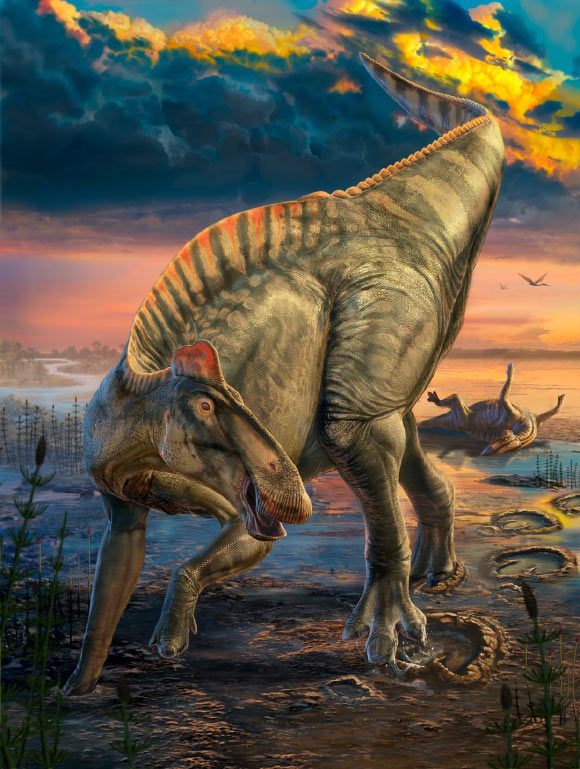Paleontologists have examined two exceptional specimens of the end-Cretaceous, duck-billed dinosaur Edmontosaurus annectens. Using an array of imaging techniques, they reconstructed the fleshy appearance of the species in life, from a tall crest over the neck and trunk to a spike row over its tail and hooves sheathing its toes; combined with fossilized footprints, the appearance of Edmontosaurus annectens is now at hand.
“It’s the first time we’ve had a complete, fleshed-out view of a large dinosaur that we can really feel confident about,” said University of Chicago’s Professor Paul Sereno, lead author of the study.
“The badlands in Wyoming where the finds were made is a unique ‘mummy zone’ that has more surprises in store from fossils collected over years of visits by teams of university undergrads.”
Using historical photos and field sleuthing, Professor Sereno and colleagues relocated the sites in east-central Wyoming where several famous dinosaur ‘mummies’ were discovered in the early 20th century, mapping out a compact ‘mummy zone.’
In those stacked river sands, they excavated two new ‘mummies’ of Edmontosaurus annectens — a juvenile and an adult — with large continuous areas of preserved external skin surface.
Working with these specimens, they reconstructed a complete, fleshy profile of the species.
“The two specimens complemented each other beautifully,” Professor Sereno said.
“For the first time, we could see the whole profile rather than scattered patches.”
The paleontologists identified a continuous midline feature that began as a fleshy crest along the neck and trunk and transitioned over the hips into a single row of spikes running down the tail — each spike positioned over a single vertebra and fitted to each other.
The lower body and tail had the largest polygonal scales, although most were tiny pebble-like scales just 1-4 mm across, surprisingly small for a dinosaur growing to over 12 m (40 feet) in length.
Wrinkles preserved over the ribcage suggest the skin of this duckbill was thin.
The hind feet of the larger ‘mummy’ held the biggest surprise: hooves.
The tip of each of the three hind toes were encased in a wedge-shaped hoof with a flat bottom like that of a horse.
The researchers used CT scans of the specimen’s feet and 3D images of the best-preserved duckbill footprint from the same time period, fitting the former into the latter.
Using information from both sources, they accurately reconstructed the appearance of the hind foot.
Unlike the forefoot that touches the ground only with its hooves, the hind feet have a fleshy heel pad behind the hooves.
“There are so many amazing ‘firsts’ preserved in these duck-billed ‘mummies’ — the earliest hooves documented in a land vertebrate, the first confirmed hooved reptile, and the first hooved four-legged animal with different forelimb and hindlimb posture,” Professor Sereno said.
The team’s paper was published today in the journal Science.
_____
Paul C. Sereno et al. 2025. Duck-billed dinosaur fleshy midline and hooves reveal terrestrial clay-template ‘mummification.’ Science, published online October 23, 2025; doi: 10.1126/science.adw3536








